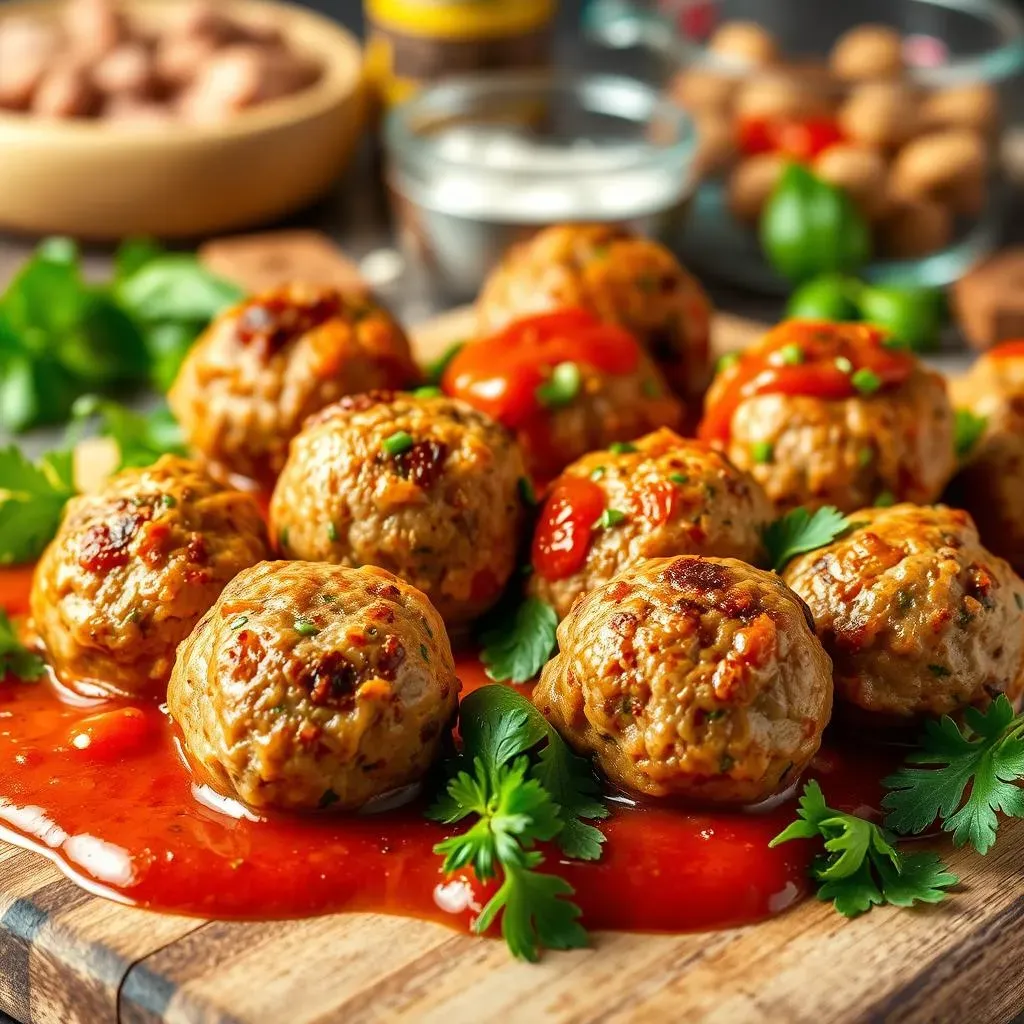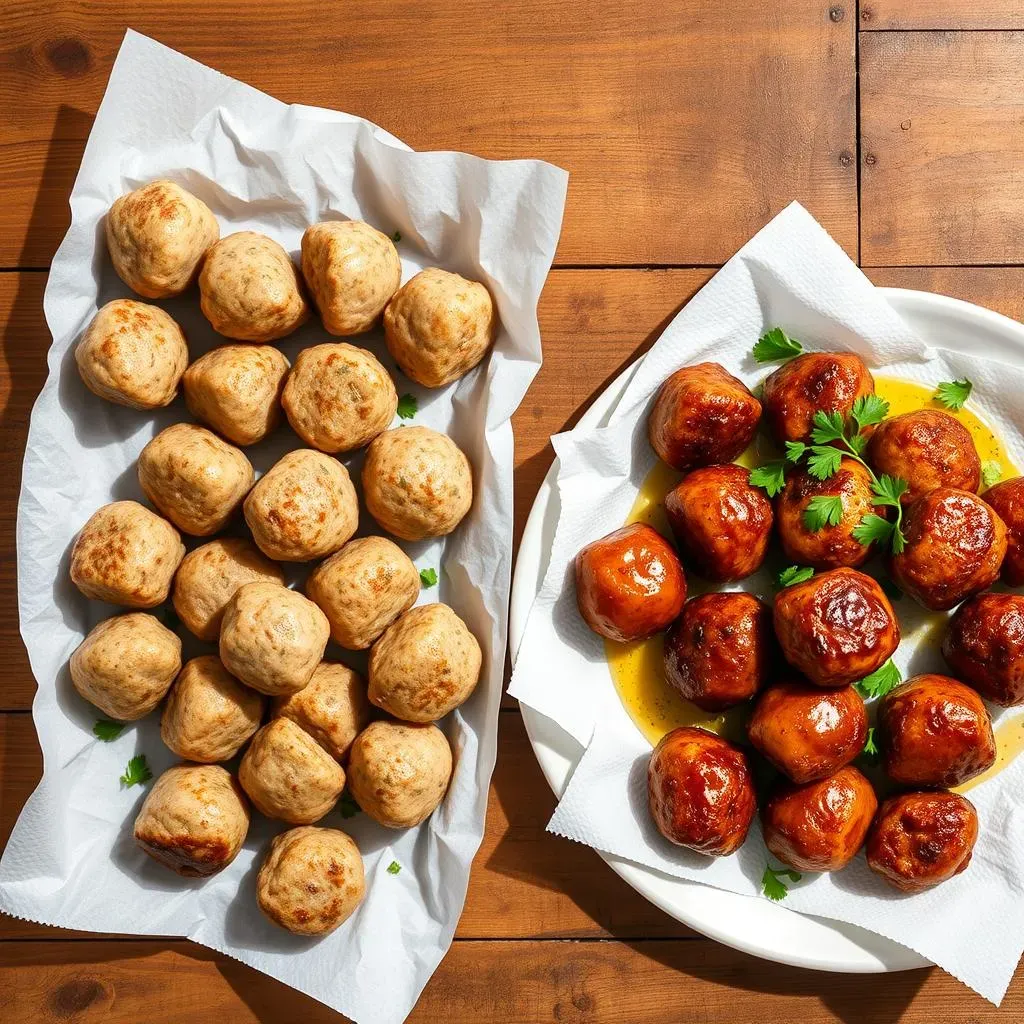Craving a comfort food classic but want a healthier spin? Look no further! This homemade turkey meatball recipe is your answer to delicious, guilt-free eating. Forget dry, bland meatballs – we're diving into a world of juicy, flavorful goodness that's surprisingly easy to achieve. Whether you're a seasoned chef or a kitchen newbie, this recipe is designed for success. We'll walk you through the simple steps, from selecting the perfect ingredients to mastering the cooking method. Get ready to discover why ground turkey makes a fantastic, lean alternative to beef, and how a few clever tricks can guarantee tender meatballs every time. Stick around as we explore creative serving suggestions, storage tips, and even some fun variations to make this homemade turkey meatball recipe your own family favorite. Let's get cooking!
Why Turkey Meatballs? A Healthier Twist on a Classic

Why Turkey Meatballs? A Healthier Twist on a Classic
so you're thinking about meatballs, right? Immediately, your brain probably jumps to beef – the classic, juicy, sometimes-greasy goodness. But let's be real, we're all trying to make slightly better choices, and that's where turkey meatballs swoop in to save the day. Ground turkey offers a fantastic way to enjoy that meatball craving without the extra baggage of saturated fat. It's like having your cake and eating (a slightly healthier version of) it too!
Think of it this way: you're still getting a protein-packed, satisfying meal, but you're also cutting back on the stuff that might make your arteries sing the blues. Plus, turkey is incredibly versatile. It soaks up flavors like a sponge, meaning you can get creative with your seasonings and sauces without sacrificing that authentic meatball taste. So, are turkey meatballs *actually* healthier? Let's break it down:
- Lower in Saturated Fat: Ground turkey generally has significantly less saturated fat than ground beef, which is a win for your heart.
- Lean Protein Source: It's packed with protein, essential for muscle building and overall health.
- Calorie Conscious: Depending on the type of ground turkey you choose (lean or regular), you can also reduce your calorie intake.
Now, don't get me wrong, I'm not saying beef meatballs are the enemy. But if you're looking for a simple swap that can make a positive impact on your diet, turkey meatballs are definitely worth a shot. Trust me, your taste buds (and your heart) will thank you!
Crafting the Perfect Homemade Turkey Meatball Recipe: Ingredients and Prep

Crafting the Perfect Homemade Turkey Meatball Recipe: Ingredients and Prep
The Turkey Talk: Choosing Your Ground Turkey
Alright, so you're ready to dive in! First things first, let's talk turkey...literally. The type of ground turkey you choose will make a difference in the final product. You'll typically find ground turkey labeled as either "ground turkey" or "ground turkey breast." The difference? "Ground turkey" can include dark meat and skin, which means more flavor and moisture, but also a higher fat content. "Ground turkey breast" is leaner, but can sometimes result in drier meatballs if you're not careful. I usually go for a blend – something around 85/15 lean-to-fat ratio – to get the best of both worlds. Don't be afraid to ask your butcher for recommendations or to grind it fresh for you!
Also, pro-tip: Avoid the super-lean stuff (99% fat-free) unless you *really* know what you're doing. It's a recipe for dry, hockey-puck meatballs, and nobody wants that. Remember, a little fat is your friend when it comes to flavor and texture.
The Supporting Cast: Binders, Seasonings, and More
turkey's the star, but every good meatball needs a solid supporting cast. This is where your binders, seasonings, and flavor boosters come in. Let's break down the essentials:
- Breadcrumbs: These act as a binder, holding everything together and adding moisture. I prefer Italian breadcrumbs for that classic flavor, but plain breadcrumbs work just as well. You can even use panko for a slightly crispier texture.
- Egg: Another essential binder! The egg helps to emulsify the ingredients and create a cohesive mixture.
- Aromatic Veggies: Onion and garlic are a must! I like to finely chop them so they distribute evenly throughout the meatballs. You can even sauté them lightly before adding them to the mix for an extra layer of flavor.
- Milk (or Broth): This helps to keep the meatballs moist and tender. A splash of milk or chicken broth does the trick.
- Seasonings: Now's your chance to get creative! Italian seasoning is a classic choice, but feel free to experiment with dried oregano, basil, parsley, red pepper flakes, or even a pinch of smoked paprika. Don't forget salt and pepper!
Here's a quick ingredient checklist:
Ingredient | Approximate Quantity | Notes |
|---|---|---|
Ground Turkey | 1 pound | 85/15 lean-to-fat ratio recommended |
Italian Breadcrumbs | 1/2 cup | Can substitute with plain or panko |
Egg | 1 large | Lightly beaten |
Onion | 1/2 medium | Finely chopped |
Garlic | 2 cloves | Minced |
Milk (or Broth) | 2 tablespoons | Adds moisture |
Italian Seasoning | 1 teaspoon | Adjust to taste |
Salt & Pepper | To taste | Don't be shy! |
With the right ingredients and a little bit of prep, you're well on your way to meatball success!
StepbyStep Guide: Making Juicy Turkey Meatballs at Home

StepbyStep Guide: Making Juicy Turkey Meatballs at Home
friend, let's get down to the nitty-gritty. Making juicy turkey meatballs isn't rocket science, but there are a few key steps to follow for guaranteed success. First, gently combine all your ingredients in a large bowl. I emphasize "gently" because overmixing is the enemy of tender meatballs! Use your hands (they're the best tools for the job) to lightly incorporate everything until just combined. The mixture should be moist but not soggy. If it seems too wet, add a tablespoon or two more of breadcrumbs. Now, here's a crucial step: let the mixture rest for about 15-20 minutes. This allows the breadcrumbs to absorb the moisture and the flavors to meld together. Trust me, it makes a difference!
Next, it's time to shape those meatballs! I like to use a cookie scoop to ensure they're all uniform in size (about 1-1.5 inches in diameter). This helps them cook evenly. Roll each scoop gently between your palms to form a smooth, round ball. Don't pack them too tightly! Place the formed meatballs on a baking sheet lined with parchment paper. This prevents sticking and makes for easy cleanup. Now, you're ready to cook 'em up! But before we get to that, let's talk about the best cooking method for juicy turkey meatballs.
Before we dive into cooking methods, let's recap the key steps for meatball success:
- Gently combine all ingredients.
- Let the mixture rest for 15-20 minutes.
- Shape meatballs using a cookie scoop for uniform size.
- Place on a parchment-lined baking sheet.
Baking vs. PanFrying: Choosing Your Turkey Meatball Cooking Method

Baking vs. PanFrying: Choosing Your Turkey Meatball Cooking Method
Baking: The Hands-Off Approach
so you've got your perfectly formed turkey meatballs ready to go. Now, how do you cook these bad boys? You've got options, my friend! First up, let's talk baking. Baking is fantastic because it's relatively hands-off. You just pop them in the oven and let the heat do its thing. It's also a healthier option since you don't need to add any extra oil. Plus, baking allows the meatballs to cook evenly, resulting in a consistent texture throughout.
To bake your turkey meatballs, preheat your oven to 375°F (190°C). Place the meatballs on your parchment-lined baking sheet, making sure they're not overcrowded. Bake for about 20-25 minutes, or until they're cooked through and lightly browned. A good way to check for doneness is to use a meat thermometer. The internal temperature should reach 165°F (74°C). Remember, turkey can dry out easily, so don't overbake them! Once they're done, let them rest for a few minutes before serving. This helps the juices redistribute, resulting in even juicier meatballs.
Pan-Frying: The Sizzle and Sear
Now, if you're looking for a little more flavor and a nice, crispy exterior, pan-frying is the way to go. Pan-frying gives you that beautiful sear that adds a ton of depth to the meatballs. It's also a faster cooking method than baking, which is great when you're short on time. However, pan-frying does require a bit more attention, as you need to keep a close eye on the meatballs to prevent burning. Also, you'll need to use some oil, so it's not quite as healthy as baking.
To pan-fry your turkey meatballs, heat a tablespoon or two of olive oil in a large skillet over medium heat. Once the oil is hot, add the meatballs to the skillet, making sure not to overcrowd them. Cook for about 8-10 minutes, turning them frequently, until they're browned on all sides and cooked through. Again, use a meat thermometer to ensure they reach an internal temperature of 165°F (74°C). Once they're done, remove them from the skillet and place them on a paper towel-lined plate to drain any excess oil. Serve immediately and enjoy that crispy, flavorful goodness!
Method | Pros | Cons |
|---|---|---|
Baking | Hands-off, healthier, even cooking | Can be less flavorful, longer cooking time |
Pan-Frying | More flavorful, crispy exterior, faster cooking time | Requires more attention, less healthy |
Serving Suggestions & Creative Twists for Your Homemade Turkey Meatballs

Serving Suggestions & Creative Twists for Your Homemade Turkey Meatballs
Classic Comfort: The Sauce is the Boss
Alright, you've got a batch of perfectly cooked turkey meatballs, now what? Let's start with the classics! The most obvious choice? A big ol' pot of marinara sauce. Whether you're using a store-bought jar or whipping up your own from scratch, simmering those meatballs in a rich tomato sauce is a guaranteed crowd-pleaser. Serve them over spaghetti, penne, or even creamy polenta for a comforting and satisfying meal. Don't forget a generous sprinkle of Parmesan cheese and a side of garlic bread for dipping!
Want to take it up a notch? Try adding a splash of red wine to your marinara sauce for extra depth of flavor. Or, for a sweeter twist, add a spoonful of balsamic glaze. The possibilities are endless!
Beyond Spaghetti: Meatball Adventures Await!
But hey, let's not limit ourselves to just spaghetti, there's a whole world of meatball adventures waiting to be explored! Think meatball subs piled high with melted mozzarella and your favorite toppings. Or how about meatball sliders for a fun and easy appetizer? You could even add them to a hearty vegetable soup for a protein boost. And don't even get me started on meatball skewers with grilled veggies – perfect for a summer barbecue!
Looking for something a little more exotic? Try making Swedish meatballs with a creamy gravy sauce and serving them over egg noodles. Or, for a spicy kick, try making Asian-inspired meatballs with a sweet and savory glaze and serving them over rice. Get creative and experiment with different flavors and cuisines! Here are some quick ideas:
- Meatball Subs: Toasted rolls, marinara, mozzarella, and meatballs.
- Meatball Sliders: Mini buns, provolone, pesto, and mini meatballs.
- Meatball Soup: Add to your favorite vegetable or minestrone soup.
- Swedish Meatballs: Creamy gravy sauce, egg noodles, and lingonberry jam.
- Asian-Inspired Meatballs: Sweet and savory glaze, rice, and sesame seeds.
Creative Twists: Level Up Your Meatball Game
Ready to really impress? Let's talk creative twists! How about stuffing your meatballs with a little surprise? A cube of mozzarella cheese, a sun-dried tomato, or even a dollop of pesto can add an unexpected burst of flavor. Or, try adding some finely chopped vegetables to your meatball mixture for extra nutrients and texture. Zucchini, carrots, and spinach all work well. Another fun twist? Use different types of ground meat! Try a blend of ground turkey and ground chicken, or even add a little bit of ground sausage for a spicier kick. The sky's the limit when it comes to creative meatball twists!
To recap, here are some ways to level up your meatball game:
Twist | Description | Flavor Profile |
|---|---|---|
Stuffed Meatballs | Add a surprise filling inside each meatball. | Varied, depending on the filling (cheesy, savory, herby) |
Veggie-Packed Meatballs | Incorporate finely chopped vegetables into the mixture. | Adds moisture, nutrients, and subtle flavor. |
Meat Blend Meatballs | Combine different types of ground meat for a unique flavor. | Complex, can be tailored to your preference (spicy, savory) |
From Our Kitchen to Yours: Mastering the Homemade Turkey Meatball Recipe
So there you have it – your guide to creating the perfect homemade turkey meatball recipe! From selecting the freshest ingredients to experimenting with your favorite sauces and serving styles, the possibilities are endless. Remember, the key is to have fun and adjust the recipe to your own taste. Whether you're looking for a healthier alternative to beef meatballs or simply want a delicious and easy meal option, these turkey meatballs are sure to become a staple in your kitchen. Happy cooking!